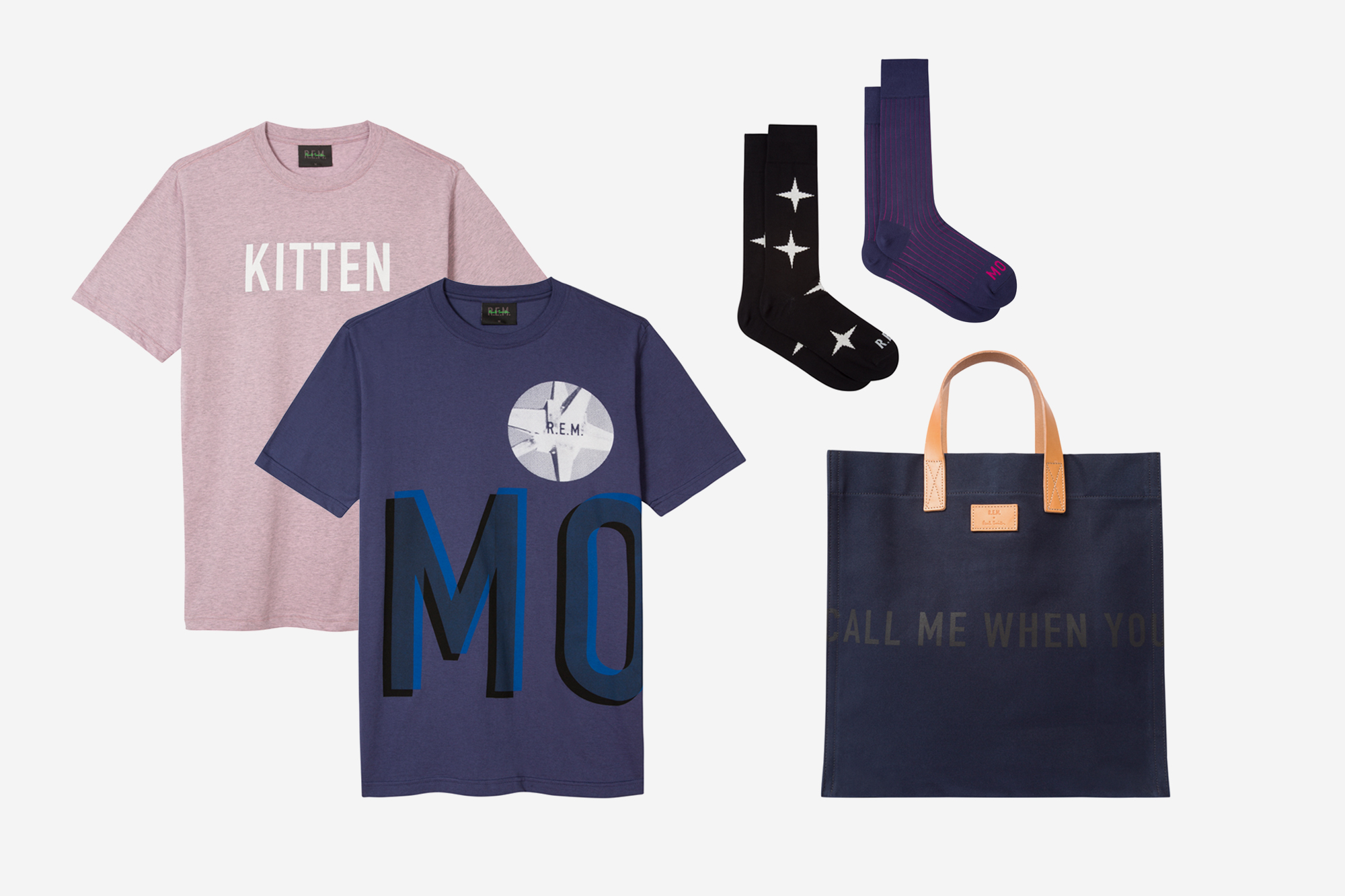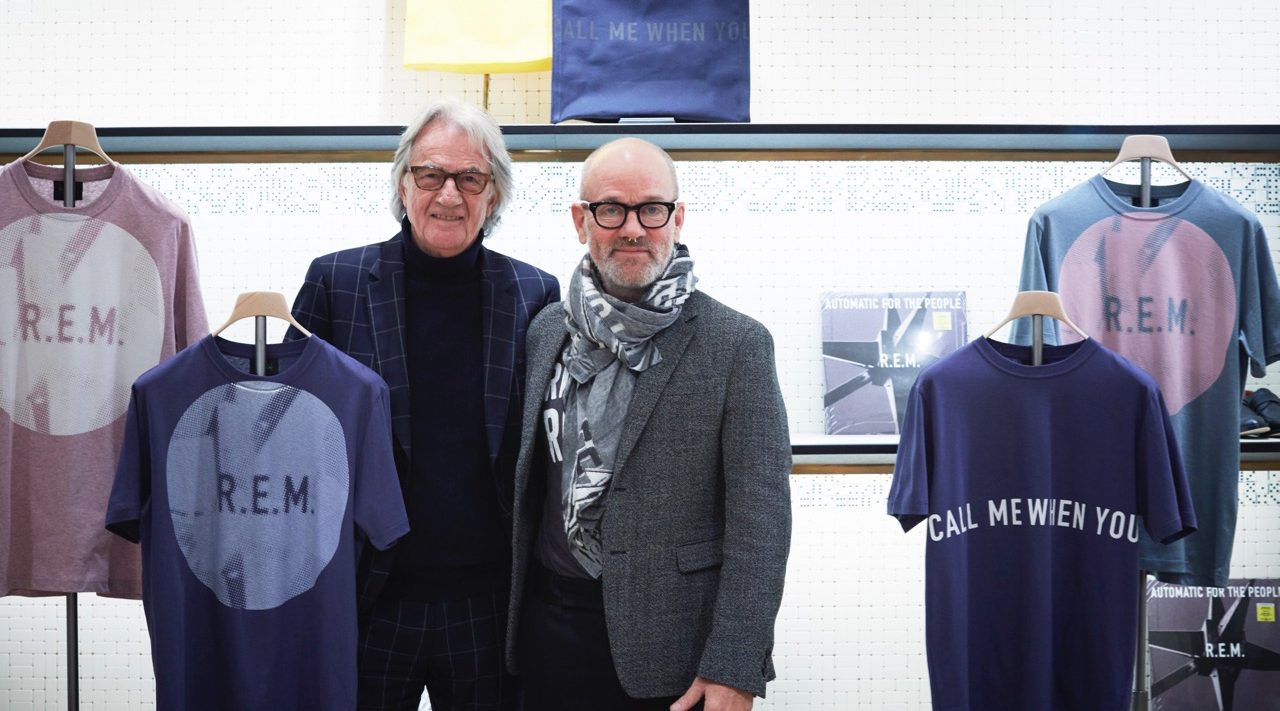WORDS
Peter Howarth
To celebrate the 25th anniversary of the release of Automatic For The People, R.E.M. has collaborated with Paul Smith on a new collection of T-shirts, accessories and original artwork. The band, and in particular lead singer-songwriter Michael Stipe, was involved in every step of creating the collection with Paul Smith, using original album artwork and lyrics, and photographer Anton Corbijn’s specially commissioned photography of the band.
‘We get involved in lots of things,’ Sir Paul Smith says, ‘But this just felt right… and it ended up being an honest collaboration. Michael [Stipe] wanted to be involved in the box, the label, the colours, Anton gave us his blessing for the photography and it was really a coming together of nice things.’
Stipe also spoke to Brummell at the launch of the collection about working with Paul Smith and why the British brand makes a natural partner for the band.
Brummell: How did this collaboration come about?
Michael Stipe: I think it came from the Paul Smith team, the idea of us collaborating together, it made perfect sense to me and felt instantly right when it was suggested.

Were you aware of Paul Smith’s aesthetic and British wit? There seems to be a lot of similarity with the way in which you look at the world.
Yes, and it’s fascinating to see it in person, his energy is contagious and he is as hyperactive as I am. But he contains this immense curiosity that is so beautiful, and really inspiring. His love of design of all types, his love of photography, his love of art, his love of music, his love of creative people, and he’s not self-obsessed at all, it’s beautiful.
Also as a 57-year-old guy who works with stylists from time to time but likes to dress himself, I would say Paul Smith and Dries van Noten are perhaps the only people that design for men over the age of 30 and infuse pattern, colour and texture into the clothes in a way that’s very male but also pushes it a little bit. You don’t find that much elsewhere.
Did you enjoy the process of working with Paul Smith?
I did, and he’s got a great team. We had 11 months to put it together, and I’m a bit of a control freak, particularly when it comes to REM. I want to make sure that whatever comes out with R.E.M.’s name on it is well designed and beautifully made.

You are the driving force in R.E.M about the kind of visual language around the band?
Yes, for better or for worse.
And now some of the R.E.M. visuals have become so iconic, the cover for Automatic For The People, for example, everyone remembers it.
I love the new cover I have to say, and speaking to Anton Corbijn who took the picture, he saw it for the first time today, the package as an album, as a boxed album and CD cover and it feels like this is how it should have been the first time. In 1992 when the album was first released, Photoshop had just come out and I was excited about the things that you could do with it. So the original cover is very beautiful but it’s very 1992, and Photoshop 101, and this new cover for the new edition is just exactly what I wanted. I told him what I wanted, I told him what to shoot, I stood there with him while he shot it, and it turned out exactly how I wanted it to look.
The cover is a picture of a sign, is that right?
It was a neon sign on top of a hotel called the Sinbad Hotel in Miami, Florida, where we were recording at the time. It blew off in a hurricane and I think it went to the trash heap. We went looking for it to try and buy it but it was long gone.

You mention being 57, but the privilege of age is being able to revisit something like this. Do you find that and do you enjoy it?
Yes. Our first album was named album of the year in 1983 over Michael Jackson’s Thriller, so you have to be OK with acknowledging the early work you did and allow that to be a part of who you are without being in competition with a younger version of yourself. You just have to be proud of it and acknowledge it.
You have always been into photography, haven’t you?
Yeah, since before music.
That’s interesting as the visual medium and the oral medium are two very different things but in your head are they the same thing?
MS: Music to me is extremely cinematic. I always needed the music in order to write the lyrics – I can always write words, follow a narrative and write thematic ideas, but to write that into a pop lyric is a very particular and bizarre skill and I honed it over several albums, growing that skill in the public eye. But music for me is extremely visual, and the difference between photography and music is not that vast to me. I would say that music touches the heart much more clearly and much more directly than most photographs, unless perhaps we’re talking about documentary or wartime journalistic photographs.
Music is unmediated, it goes straight in there.
It plays to a different part of the brain.
The collection is now on sale from Paul Smith’s website.




